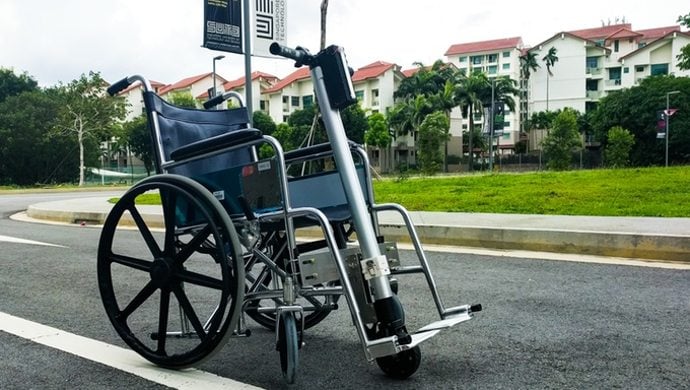EMMA can go up to a top speed of 10 kilometres per hour

Anyone has ever had to spend a day in a wheelchair can attest to how painstakingly difficult it is to get around with it, especially on an uphill slope — a journey that might leave one with aching arms and gasping for air. Intricate motorised options might ease the physical strain, but not so much on the purse — some cost S$2,500 (US$1,750) upwards, not a solution ideal for older folks.
A group of engineering students from Singapore University of Technology and Design (SUTD) have banded together to form Team Mobearlize, with the aim to develop a more efficient and affordable motorised wheelchair option. The result of their one-year project: a retrofit device that transforms any ordinary wheelchair into a motorised personal mobility unit.
Also Read: This Singapore startup wants to roll out autonomous drones to shake up how warehouses operate
The unit consists of one powered wheel and two wheel attachments attached to the hub motor. The powered wheel is connected to a detachable steering shaft, allowing riders to control acceleration and brakes much like a scooter, except that, well, it’s five-wheeled. The whole unit is attached to the wheelchair using a combination of mounting plates and attachment blocks, which have adjustable elevation to suit different wheelchairs.
For adventurous riders eager to go full throttle and zip around like a pumped-up street racer, disappointment awaits — EMMA can only achieve a top speed of 10 kilometres per hour (which is well within LTA’s speed regulations for personal mobility aids).
EMMA runs on lead batteries that have a charging time of two hours and lasts for 25 kilometres before the next recharge.

Besides being highly compact, it is also very lightweight — slightly below 8 kilogrammes. The ability to keep the unit simple, lean and travel-friendly is essential for its target market, many of whom are constrained physically and sometimes have to be self-dependent. With its intuitive steering shaft joints system, riders (and caregivers) can easily assemble and detach the shaft without the need for additional tools such as screwdrivers.
Another clear advantage of being lean and lightweight is that by not adding any bulk to the already hefty frame, riders do not have to worry about compromising their travel routes, all wheelchair-friendly areas will still be accessible.
Also Read: India’s Hyperloop experiment is a victory for moonshots across Asia
For now, EMMA is still in its beta form, there are still several essential features not implemented. It can’t break completely on a steep slope, nor can it go in reverse. Additionally, it requires an initial manual push to get the device to start. On its Kickstarter page Mobearlize promises that they will work on integrating these functionalities before finalising the prototype. Once it’s done, it promises to be cost effective — about half the price of most motorised wheelchair options.
Mobearlize is just shy of about S$700 (US$490) before it hits its crowdfunding goal of S$5,000 (US$3,500). With three days to go, it needs all the support to help make everyday travel for disabled folks less like a crawl and more of a sprint.
—
Image Credit: EMMA
The post This Singaporean device can power up any ol’ wheelchair with its motor appeared first on e27.